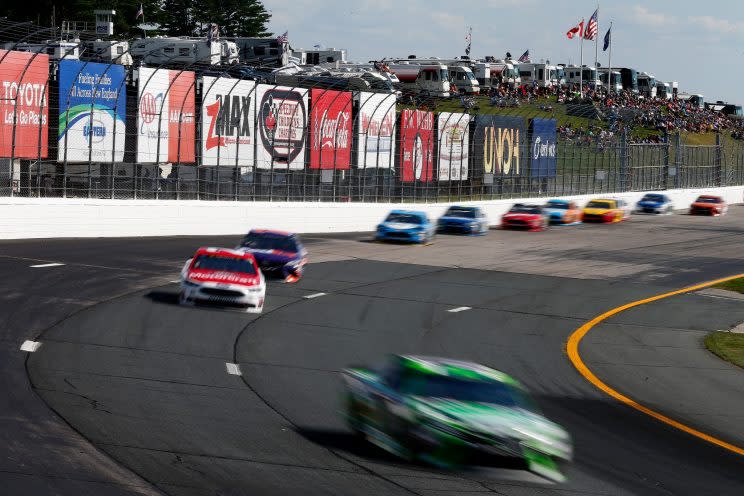Takeaways from New Hampshire: How much of an effect did sticky stuff have?
Consider our Takeaways feature to be the home of our random and sometimes intelligent musings. Sometimes the post may have a theme. Sometimes it may just be a mess of unrelated thoughts. Make sure you tweet us your thoughts after the race or email your post-race rants via the link in the signature line below.
• If you watched all or part of Sunday’s race at New Hampshire, you know there was sticky stuff on the track in the lower and upper grooves. Talk about the product was unavoidable.
But … did it work? And if it did, just how better did it make the racing?
“I don’t know if the compound made things any racier,” Brad Keselowski said after exiting his car. “It was certainly different but I don’t know if it was — I have to think about that one.”
It was certainly different watching the race. New Hampshire’s preferred lane is one groove off the apron of the track. Immediately as the race started, drivers on the outside put their right-side tires on the high groove application of traction compound while drivers on the inside put their left-side tires on the low groove application.
And while the existence of the traction compound was noticeable during the early stages of the race, some drivers said it wore off as the race went on.
“I think it really kind of disappeared pretty early. The bottom lane had a little more grip than the top lane,” Danica Patrick said. “The top lane was just there from the beginning. Instead of it being the second lane it was the third lane. Did [the compound] widen it out more so you could take the bottom, kind of slide down, come back off early in a run when tires were better? Yeah. But it was still basically the same and still hard to pass.”
Kyle Larson, who finished second, said he saw a noticeable difference in the quality of racing, especially after restarts.
“Restarts were way more exciting, I thought,” Larson said. “I thought you could run three or four different lanes, and a lot of times I found myself in a three‑wide situation. It was fun. I normally don’t ‑‑ not necessarily enjoy coming here, but it hasn’t been one of my favorite racetracks because it is so one lane, but today I thought there was a lot of different lanes you could run, and it was all because of the [compound] that they put on the track.”
We’re guessing the sticky stuff will be back on the track for the fall race at New Hampshire. It certainly didn’t negatively impact the racing quality, and NHMS may have a better idea of how to apply it to make it more durable before the fall rolls around.
“It was different and I enjoy different,” Jimmie Johnson said. “It wore off as the day wore on. An early opinion of it and making it work for you was a bit of a distraction once you got deeper into the race and the adjustments you needed to make on your car. I didn’t see any negatives from it so I think there’s a positive to it and I’ll definitely be interested to hear what the fans have to say about it.”
• While the compound may not have negatively affected the racing quality, it’s fair to wonder if it negatively impacts the quality of the racing surface.
The race was red-flagged between the first and second stages as workers fixed a hole that had formed in turns 3 and 4. In the driver’s meeting before Sunday’s race, NASCAR officials told drivers the track had patched spots in each of the four corners after Saturday’s Xfinity race. That race was also run with traction compound on the track.
Was the combination of hot tires on traction compound helping rip up parts of the track, especially those parts of the track that had asphalt sealer on them? It’s a worthy question to ask.
Will be interesting to see how aggressive tracks get with it after seeing it pull up asphalt chuncks off the surface this weekend. https://t.co/Z078mbViLV
— Brad Keselowski (@keselowski) July 17, 2017
NASCAR got lucky that the red flag for track repairs was incredibly brief. It can’t afford to have a race delayed by hours as track crews fix a pothole that may be caused because of traction compound on the track. And if traction compound isn’t a very good thing for a track’s surface, it could also speed up the need for tracks to repave.
• Dale Earnhardt Jr. stayed out on old tires with 35 laps to go. But he was the only driver to try that strategy.
Predictably, that didn’t work out.
Junior became a rolling chicane as teams with fresher tires swarmed around him and finished 18th with what he said was probably a best-case finish of 10th had he tried a conventional strategy.
“That is kind of risk we’ve got to take,” Earnhardt Jr. said. “We were hoping [Keselowski] and a couple of other guys that were kind of on the same strategy would stay out behind us. But, I knew when nobody stayed out that as fast as that front four or five were it was impossible to hold them off. We’ve got to take risks though, but hopefully we’ve got a faster car when we are doing it and that might give us a little better shot at it.”
Buried at 21st in the points standings, Earnhardt Jr. isn’t going to make the playoffs on points. He has to do it via a win. So what the team tried Sunday at New Hampshire was necessary. It didn’t work out, but it wasn’t going to work out if the team played the race like everyone else did.

– – – – – – –
Nick Bromberg is the editor of Dr. Saturday and From the Marbles on Yahoo Sports. Have a tip? Email him at nickbromberg@yahoo.com or follow him on Twitter!



